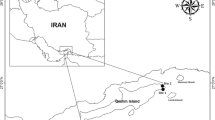Abstract
Microalgae composition, abundance, diversity and biomass of the Qua Iboe Estuary mangrove swamp were studied. The results revealed the rich assemblage of the brackish ecosystem. Six major taxanomic classes were encountered. These were the Bacillariophyceae, Cyanophyceae, Chlorophyceae, Chrysophyceae, Euglenophyceae and Phaeophyceae. Their composition, abundance and diversity exhibits strong seasonal variation. Variations between pelagic and sedimentary habitats were also noticed. The diatoms (Bacillariophyceae) dominated the habitats. Actinoptychus undalatus, Navicula radiosa and Amphora ovalis co-dominated the pelagic water column; while the epipellic (intertidal) and benthic (subtidal) sediments were co-dominated by A. ovalis and Actinoptychus undulatus. Analyses of the Shannon’s index of general diversity (H1), McArthur-Terborgh species equitability index (E) and Simpson’s index of dominance (D) of the microalgae communities revealed that A. ovalis with a mean H 1-value of 0.25, E-value of 0.08 and D-value of 0.05 was the most prevalent genus in the mangrove ecosystem despite its uneven distribution. The densities of the microalgae communities corresponded with their biomass statuses and were seriously impacted by oil spillage. This forms the basis of concern because the estuary is associated with a high probability of major oil pollution with serious consequences for ecological stability and fisheries.


Similar content being viewed by others
References
APHA (1998) Standard methods for the examination of water and waste water, 20th edn. American Public Health Association
Alongi DM (1990) Abundance of benthic microfauna in relation to outwelling of mangrove detritus in a tropical coastal region. Mar Ecol Prog Ser 63:53–63
Beukema JJ (1976) Biomass and species richness of the macro benthic animals living on the tidal flat of the Dutch Waden sea. Netherlands J Sea Res 10(2):236–261
Bingham B, Young CM (1994) Stochastic events and dynamics of a mangrove root community. Marine Ecol 16:145–163
Carmichael WW (1981) The water environment: algal toxins and health. Plenum Press, New York, pp 161–172
Dahlin J, Hess S, Duncan P, Powell CB (1985) Composition of the phytoplankton and zooplankton communities of the Niger Delta. The Petroleum Industry and Nigerian Environment. Published by the Petroleum Inspectorate, Nigerian NationalPetroleum Corporation Environmental Planning and Protection Division and the Federal Ministry of Works and Housing, pp 217–229
Davies CC (1972) Plankton dynamics in a New Foundland Lake. Verh Internat Verein Limonol 18(1):278–283
Davies CC (1995) Marine and freshwater planktons. Michigan State University Press, pp 154–394
Day JW, Hall CAS, Kemp WM, Yez-Arancbia A (1989) Estuarine ecology. John Wiley and Sons, New York, pp 61–64
Essien JP, Ubom RM, Antai SP (2005) Productivity and distribution of epipellic microalgae along salinity gradients in mangrove swamp of the Qua Iboe Estuary (Nigeria). Environ Monitoring Assessment 121:65–75
Essien JP, Antai SP (2005) Negative effects of oil spill on beach microalgae in Nigeria. World J Microbiol Biotechnol 24(4):567–573
Essien JP, Ubom RM (2003) Epipellic algae profile of the mixohaline mangrove swamp of Qua Iboe River Estuary (Nigeria). The Environmentalist 23(4):323–238
Farnsworth EJ, Ellison AM (1996) Scale dependent spatial and temporal variability in biogeography of mangrove root epibiont communities. Ecol Monogr 66:45–66
Freckman DW, Blackburn TA, Brussard L, Hutchings P, Palmer MA, Snelgrove PVR (1997) Linking biodiversity and ecosystem functioning of soils and sediments. Ambio 26(8):556–562
Galvao HM (1997) Microbial ecology of a brackish water system (Western Baltic). Universidale to Algarve, Gambelas, 8000, Faro, Portugal
Gest H, Pietro AS, Vernon LP (1962) Bacterial photosynthesis. The Antioch Press Yellow Springs, Ohio, p 523
Hall G (1996) Methods for the examination of organismal diversity in soil and sediment. CAB International, New York, p 307
Laegdsgaard P, Johnson CR (1995) Mangrove habitats as nurseries; unique assemblages of juvenile fish in subtropical mangroves in eastern Austrialia. Marine Ecol Process Series 126:67–81
Maosen H (1978) Illustration of freshwater planktons. Academic Press, London, p 108
Moore RE (1981a) Toxins and marine blue-green algae. In: Carmichael WW (ed) The water environment: algal toxins and health. Plenum Press, New York, pp 15–23
Moore RE (1981b) Constituents of blue-green algae. In: Schever P (ed) Marine natural products, vol 4. Academic Press, London, pp 1–52
Opute FI (1991) A check list of marine phytoplankton. Nigeria J Bot 4:227–254
Opute FI (1990) Phytoplankton flora of the Warri-Forcados Estuaries of Southern Nigeria. Hydrobiologia 208:101–109
Perry DM (1988) Effects of associated fauna on growth and productivity in the red mangrove. Ecology 69:1064–1075
Smith AM (1966) Cryptogamic botany, 2nd edn, vol 1. McGraw Hill Book Company, New York
Ubom RM, Essien JP (2003) Distribution and significance of epipsammic algae in the coastal shore (Ibeno beach) of Qua Iboe River Estuary, Nigeria. The Environmentalist 23(2):109–115
Ukpong IE (1995) Vegetation and soil acidity of mangrove swamp in Southeastern Nigeria. Use Manage 11:141–144
Ukpong IE (1991) The performance and distribution of species along soil salinity gradients of mangrove swamps in South eastern Nigeria. Vegetation 95:63–70
Underwood AJ, Chapman MG (1995) Coastal marine ecology of temperate Australia. Institute Marine Ecology, University of Sydney, UNSW
Author information
Authors and Affiliations
Corresponding author
Rights and permissions
About this article
Cite this article
Essien, J.P., Antai, S.P. & Benson, N.U. Microalgae biodiversity and biomass status in Qua Iboe Estuary mangrove swamp, Nigeria. Aquat Ecol 42, 71–81 (2008). https://doi.org/10.1007/s10452-007-9083-5
Received:
Accepted:
Published:
Issue Date:
DOI: https://doi.org/10.1007/s10452-007-9083-5




